
St. John's Cathedral is a Romanesque cathedral in the Lebanese city of Byblos. The church is dedicated to St. Jean Mark, Byblos' patron saint and founder of the town's initial Christian community.

St. John's Cathedral is a Romanesque cathedral in the Lebanese city of Byblos. The church is dedicated to St. Jean Mark, Byblos' patron saint and founder of the town's initial Christian community.
The church was constructed in 1115 by the Crusaders, originally known as the Cathedral of Saint John the Baptist. A number of environmental disasters hit the structure including earthquakes, and the church fell into disrepair until 1764, when Yusuf Shihab donated the block to the Lebanese Maronite Order; they restored the building and reopened it in 1776. Shelling during the Oriental Crisis of 1840 once more inflicted damage, but it was repaired; the church is open for visitors today. [1] [2]

Byblos, also known as Jubayl or Jebeil, is a city in the Keserwan-Jbeil Governorate of Lebanon. It is believed to have been first occupied between 8800 and 7000 BC and continuously inhabited since 5000 BC, making it one of the oldest continuously inhabited cities in the world. During its history, Byblos was part of numerous civilizations, including Egyptian, Phoenician, Assyrian, Persian, Hellenistic, Roman, Fatimid, Genoese, Mamluk and Ottoman. The city is a UNESCO World Heritage Site.

The Armenian Catholic Church is one of the Eastern particular churches sui iuris of the Catholic Church. It accepts the leadership of the Bishop of Rome, known as papal supremacy, and therefore it is in full communion with the Catholic Church, including the Latin Church and the 22 other Eastern Catholic Churches. The Armenian Catholic Church is regulated by Eastern canon law, namely the Code of Canons of the Eastern Churches.

Amioun is the capital of the predominantly Greek Orthodox Koura District in the north of Lebanon.

Byblos District, also called the Jbeil District, is a district (qadaa) of the Keserwan-Jbeil Governorate of Lebanon. It is located to the northeast of Lebanon's capital Beirut. The capital is Byblos. The rivers of al-Madfoun and Nahr Ibrahim form the district's natural northern and southern borders respectively, with the Mediterranean Sea bordering it from the west and Mount Lebanon from the east, separating it from the adjacent district of Baalbek in the Beqaa Valley.
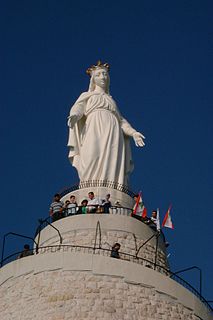
The Shrine of Our Lady of Lebanon is a Marian shrine and a pilgrimage site in the village of Harissa in Lebanon.
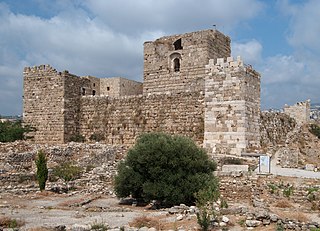
Byblos Castle is a Crusader castle in Byblos, Lebanon. In Crusader times it was known as the Castle of Gibelet, also spelled Giblet, which belonged to the Genoese Embriaco family, Lords of the city. It is adjacent to the Phoenician archaeological site containing the ruins of the Temple of Baalat Gebal and the Temple of the Obelisks.

Qartaba is a mountainous town in the Byblos District of the Keserwan-Jbeil Governorate, Lebanon. It is located 57 kilometers north Beirut on the mountains above Byblos at an average altitude of 1,250 meters. Qartaba is surrounded by olive groves, apple orchards, and vineyards.
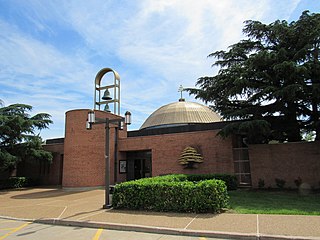
Maronite Eparchy of Our Lady of Lebanon, headquartered in St. Louis, Missouri, is an entity pertaining to the Apostolic Maronite Patriarchal Church of Antioch and includes the Maronite faithful in the western and central United States. In conformity with the Code of Canons of the Eastern Churches (CCEO), the Eparchy is under the direct jurisdiction of the Roman Pontiff. In 2013 there were 52,300 baptized. It is currently ruled by eparch Abdallah Elias Zaidan, MLM.

The Cathedral of Saint Elias and Saint Gregory the Illuminator is a cathedral of the Armenian Catholic Church in Debbas Square in downtown Beirut, Lebanon. Construction was funded in 1928 by Pope Pius XI. It is the cathedra of the Armenian Catholic Patriarchate of Cilicia. The order in which the two eponymous saints are presented in the cathedral's name, Saint Elias and Saint Gregory the Illuminator, is not fixed.
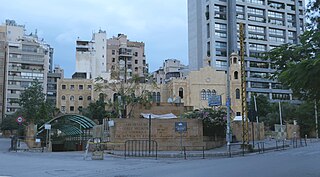
The Archeparchy of Beirut and Byblos is a metropolitan eparchy of the Melkite Greek Catholic Church since 1881, an Eastern Catholic church in communion with the Roman Catholic Church. Located in Lebanon, it includes the cities of Beirut and Byblos, and in terms of population, it is the largest Melkite eparchy in the Middle East. Its current Eparch, Georges Wadih Bacouni, S.M.S.P., was elected in November 2018.

The architecture of Lebanon embodies the historical, cultural and religious influences that have shaped Lebanon's built environment. It has been influenced by the Phoenicians, Romans, Byzantines, Umayyads, Crusaders, Mamluks, Ottomans and French. Additionally, Lebanon is home to many examples of modern and contemporary architecture. Architecturally notable structures in Lebanon include ancient thermae and temples, castles, churches, mosques, hotels, museums, government buildings, souks, residences and towers.
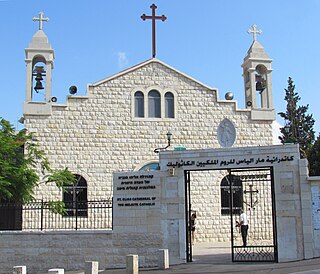
Melkite Greek Catholic Archeparchy of Akka is an Eastern Catholic diocese of Melkite Greek Catholic Church, directly subject to the Melkite Patriarch of Antioch. Its Cathedral episcopal see is St. Elijah Greek-Melkite Cathedral, in Haifa.

Melkite Greek Catholic Archeparchy of Tyre is a metropolitan see of the Melkite Greek Catholic Church. In 2009 there were 3,100 baptized. It is currently governed by an Apostolic Administrator, Archbishop Elie Bechara Haddad, B.S., because of the 31 January 2021 removal of Archeparch Michael Abrass, BA.
Melkite Greek Catholic Archeparchy of Tripoli(in Latin: Archeparchy Tripolitana Graecorum Melkitarum) is a diocese of the Melkite Greek Catholic Church suffragan of the Melkite Greek Catholic Archeparchy of Tyre. It is governed by Archeparch Eduard Daher, BC.
Saint Elias Greek Catholic Cathedral is a Melkite Greek Catholic cathedral located in downtown Beirut, Lebanon, dedicated to Saint Elias, completely restored after the Lebanese Civil War (1975–1990) on previous constructions dating to a Choueirite convent from the 19th century. Its plan followed the Byzantine style.
The Maronite Catholic Archeparchy of Tripoli is a non-Metropolitan Archeparchy of the Maronite Church in the north-west of Lebanon.

Maronite Catholic Eparchy of Byblos is an eparchy of the Maronite Church immediately subject to the Maronite Patriarch of Antioch in Lebanon. In 2013 there were 160,000 baptized. It is currently governed by Eparch Michel Aoun.

In the Catholic Church, a basilica is a designation given by the Pope to a church building. Basilicas are distinguished for ceremonial purposes from other churches. The building need not be a basilica in the architectural sense. Basilicas are either major basilicas – of which there are four, all in the Diocese of Rome – or minor basilicas, of which there were 1,810 worldwide as of 2019.
Coordinates: 34°7′17.35″N35°38′42.73″E / 34.1214861°N 35.6452028°E